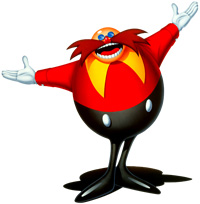As a kid in 1993, nothing was cooler
than Sonic the Hedgehog. The games had a pacing and attitude that
Mario games, fun as they were, just couldn't compete with. So when
Sonic got his own cartoon show – two of them, in fact – I was in
nerd heaven. Here at last was a cartoon show (my second favorite pastime) based on a video game (my favorite pastime) that was actually really good.
For some strange reason, Sega chose to
run two different American Sonic cartoon shows at the same time: The
Adventures of Sonic the Hedgehog,
and Sonic the Hedgehog (fans
often refer to the latter show as “SatAM” for clarity's sake, refering to the time slot it ran in , Saturday mornings). As
if this wasn't confusing enough already, Jaleel “Steve Urkel”
White provided the voice of Sonic in both shows. The similarities end
there, however, with Adventures being a slapstick farce and SatAM
being relatively dark and serious for a children's cartoon show. Oh –
and that theme song. So much delicious cheese.
Some critics
will tell you that neither show holds up
well, and that's certainly true of Adventures. But something about
SatAM made it stand out from lighter fare like The Super Mario Brothers Super
Show or The Legend of
Zelda. While those shows, and
Adventures, made merry with the source material, SatAM transformed
the pixelized characters into living, breathing creatures in a
believable setting. Plots had consequences beyond a single episode.
New characters came and went, villains rose and were defeated. The
show had a continuity that most American cartoons of that time period
lacked, especially ones based on video games.
Kids these days might not realize that
Sonic didn't always battle Dr. Eggman. Well, okay, in a way he did.
But back in 1993, the villain went by the name Dr. Ivo Robotnik, and
he was awesome. See, in Japan, Sonic's nemesis was always called Dr.
Eggman – a goofy, cartoonish mad scientist full of bluster. But in
America the name “Eggman” was apparently deemed too silly, and he
was given the less-insulting moniker “Robotnik” in the
instruction manual for the original Sonic the Hedgehog.
The name stuck in the West.
In
SatAM, Robotnik evolved even further away from his Japanese self,
retaining his portly appearance but gaining black and red robot eyes,
high tech gauntlets, outrageous shoulder pads, and a classic
supervillain cape. His demeanor changed as well. While Adventure's
Robotnik was bumbling and over-the-top, similar to his Japanese incarnation, the Robotnik of SatAM was downright sinister, with a
low-pitched growl for a voice provided by the prolific and talented
Jim Cummings. This Robotnik was a ruthless, backstabbing oppressor of
civilizations who knew just how evil he was and loved it.
SatAM
came at a time when the boundaries of Sonic's universe hadn't been
established. The Genesis games had little in the way of plot, no
voice acting, and only crude pixels to convey emotion. This meant
that as a kid, I had no idea that SatAM was straying away from Sega's
original vision of Dr. Eggman. It wasn't until Sonic
Adventure for the Sega Dreamcast
that fans like me realized just how clownish Eggman was supposed to
be – to us, he was that megalomaniacal genius with the cape and the
robot eyes. The goofball in Sonic Adventure wasn't sinister. He was
certainly amusing, but because of that you never feel truly
threatened by him.
Another
huge change SatAM made was giving Sonic a whole team of Freedom
Fighters to help him battle Robotnik, such as Princess Sally, the
rightful chipmunk monarch of Mobius, Rotor the mechanical genius
walrus, half-roboticized Bunny Rabbot, and Antoine the rapier-wielding fox (and unflattering French stereotype). These characters were all
memorable, even lovable, and made Sonic's world feel populated and
vibrant. Instead of just being a lone wolf, Sonic now had to depend
on others. This element of teamwork helped to show how the odds were
stacked against the good guys: Robotnik had a city-sized fortress
full of nightmarish robots, and even Sonic couldn't go it
alone. The stakes were always high in SatAM, which is what kept me
glued to my television set week after week.
SatAM
unfortunately occupied a rather niche market of young kids who played
video games, which meant that it couldn't last forever, especially up against powerhouse shows like Mighty Morphin Power Rangers. Only two
seasons were ever made, and when it was canceled suddenly in 1994 it
left several plots unresolved. The meager 26 episodes are as
disappointing to the show's small army of stalwart fans as Firefly's
cancellation is to the Whedonites. It's especially painful when you
consider that Adventures has 65 pointlessly silly (but entertaining
in their own way) episodes. Fortunately, the long-running Archie
Comics Sonic the Hedgehog title
largely followed the show while it was on, and went on to expand on
and wrap up most of the main plots.
SatAM
was added to Netflix last year, along with Adventures. For those of
you who had fond memories of it as a kid, it's definitely worth
returning to the world of Mobius. Sure, the show's a bit cheesier
than you remember, but it definitely stands up better than Teenage
Mutant Ninja Turtles. And for
those of you who've never seen it before, you should check it out.
It's not fine art, but definitely blows every other video game
cartoon show out of the water.


No comments:
Post a Comment